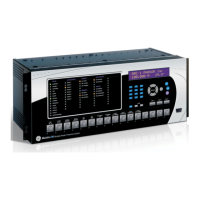5-98 F35 MULTIPLE FEEDER PROTECTION SYSTEM – INSTRUCTION MANUAL
PRODUCT SETUP CHAPTER 5: SETTINGS
5
Configuration Type
Range: G2, E3-2.0
Default: G2
This setting is read only. It specifies the method used to describe GOOSE subscription configuration in SCL. See the UR
Family Communications Guide for details. In the G2 mode, the CID file contains IED elements for IEDs subscribed to by
this IED containing GOOSE subscription information. In the E3 2.0 mode, the CID file has only one IED element and
GOOSE subscription information is coded in data objects in the standard LGOS logical node used to monitor reception of
the subscribed GOOSE. UR 7.30 or later accepts either mode. The set value is for the entire EnerVista installation and is
preserved between sessions. To change this global field, click File > Preferences and access the IEC 61850 panel; you do
not need to be connected to the device.
Logical devices
The Logical Devices panel contains IEC 61850 settings relevant to the configurable logical devices feature, wherein logical
device naming can be reconfigured and logical nodes re-assigned.
The path is Settings > Product Setup > Communications > IEC 61850 > Logical Devices.
Figure 5-46: Default IEC 61850 Logical Devices panel with devices middle and nodes right
To configure logical devices and nodes:
1. Right-click an entry and edit an existing device, add a new one, or move a logical node. The rest of this section
explains the window and how to perform these actions.
The default logical device categories are as follows:
• Master — Communications, including GOOSE, reports, Remote I/O, Virtual Inputs, Modbus, DNP, and setting group
control
• System — Power system devices: breakers, switches, CTs, VTs, and so on, including interfaces to these, such as AC
inputs, contact I/O, transducer I/O, HardFiber I/O
• Prot — Protection and protection-related functions
• Ctrl — Control and monitoring functions
• Meter — Metering and measurement functions
• Gen — FlexLogic, Virtual Outputs, non-volatile latches, FlexElements, recording (for example oscillography), security,
front panel, clock
For the Master logical device, the following logical nodes have fixed assignment:
• The LLN0 in the Master logical device, which includes setting group, GOOSE and report control blocks, and datasets
• LPHD1 — Models common issues for physical devices
• GGIO1 — For unmapped FlexLogic operands

